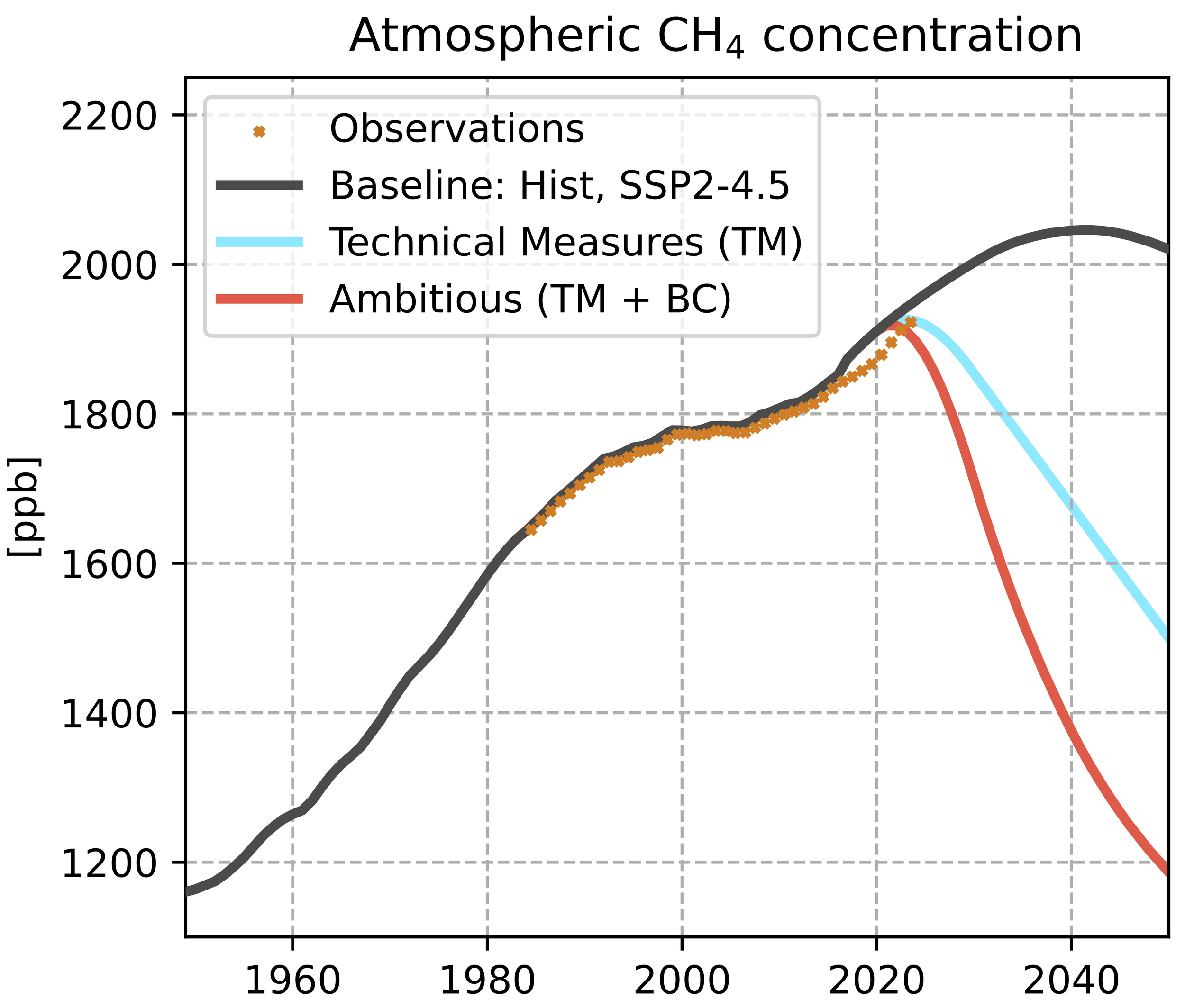
The MethaneMIP simulations
Motivation
It is unequivocal that significantly reducing methane emissions will slow global warming and its associated impacts over the coming decades. However, considerable uncertainty remains regarding the exact magnitude of near-term warming that could be avoided. Currently, estimates of the climate benefits from methane mitigation largely derive from climate emulators, which are largely simplified representations of the climate system, and a limited set of studies based on comprehensive climate models.
We identified a pressing need for a coordinated inter-model comparison project which uses state-of-the-art ESMs in which all modelling groups prescribe identical reductions in methane concentrations, all modelling groups use the same baseline scenario, and sufficient ensemble members are simulated to investigate the broader climate and health impacts of methane mitigation. The MethaneMIP project has been envisioned to undertake these tasks.
Research questions
MethaneMIP aims to tackle the following research tasks:
Produce a multi-model estimate of the climate benefits of methane emissions reductions under realistic methane mitiga- tion scenarios for the period 2020-2050 as simulated by state-of-the-art Earth System Models.
Understand which climate events projected to occur by 2050 may be delayed or avoided by curbing methane emissions.
Provide a robust estimate of when the climate signal from reduced methane emissions could expect to be detected in the presence of internal climate variability.
Provide a comprehensive estimate of the health impacts of simulated reductions in ozone under the methane mitigation scenarios.
Produce a multi-model estimate of the potential impacts of the Global Methane Pledge.
Evaluate how prescribing methane emissions rather than concentration in Earth System Models influences the estimated impacts of methane mitigation.
Explore how natural sources of methane may respond to methane mitigation.
Further our fundamental understanding of how methane is simulated by Earth System Models, such as its atmospheric lifetime
Diagnose the role of methane mitigation in overshoot scenarios in which climate targets are temporarily breached.
The MethaneMIP Scenarios
The core MethaneMIP simulations are being completed with state-of-the-art Earth System Models using two methane mitigation scenarios: Technical Measures (TM) and Ambitious (TM+BC). Both scenarios cover the three decades 2020-2050 and will be used to explore the climate and health impacts by the mid-21st century of targeting methane emissions reductions as a core part of global climate mitigation strategy, in addition to their impacts on air quality and vegetation.
Core simulations
Branched from SSP2-4.5 in 2020 (the CMIP6 middle of the road scenario).
Concentration-driven simulations.
Forcing identical to SSP2-4.5 except methane concentration is prescribed following one of the two methane mitigation pathways (Technical Measures or Ambitious).
A minimum of five ensemble members are requested for the period 2020-2050.
Non-standard variables which are highly relevant for health and policy such as hourly surface ozone are requested to be output.
Technical Measures (TM) scenario
The Technical Measures methane reduction scenario (blue line) represents an implementation of technically feasible mitigation measures to reduce methane emissions, many of which are low or negative cost. This scenario is referred to in the shorthand as TM. This scenario is approximately consistent with the Global Methane Pledge: there is a 27% reduction of methane emissions in 2030 relative to 2020. Of the emissions reductions by 2050, approximately half comes from the energy sector, a quarter comes from the agriculture sector and a quarter comes from the waste sector.
Ambitious (TM+BC) scenario
The Ambitious methane reduction scenario (red line) builds upon the Technical Measures scenario with the addition of emission reductions from widespread behavioural changes such as dietary shifts. This scenario is referred to in the shorthand as TM+BC, which stands for Technical Measures plus Behavioural Change. One of most consequential of these behavioural changes in terms of reducing methane emissions would be a sustained dietary shift, either towards vegetarianism or through less consumption of meat and dairy in aim of healthier and more balanced diets. This scenario involves more dramatic reductions than envisioned under the Global Methane Pledge: 2030 emissions are nearly 50% lower than in 2020. This scenario is labelled as ‘Ambitious’ because achieving global behavioural change for the purpose of climate change mitigation efforts is a tough challenge.
Timeline
Summer 2025 Core simulations completed with chem models
Summer 2025 MethaneMIP protocol released
Autumn 2025 Core simulations completed with non chem models
Winter 2025 Emissions driven simulations
Future work
Flagship simulations
Emissions driven simulations
Emulator work
Using the results to improve emulators
Health impacts
Downscaling using techniques for health impacts
